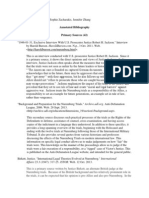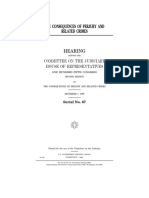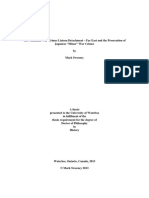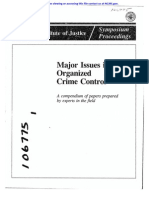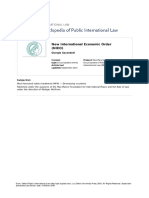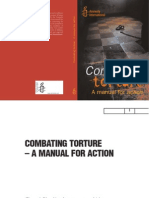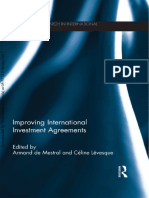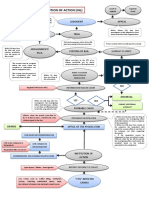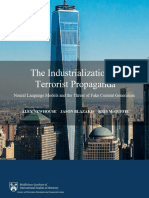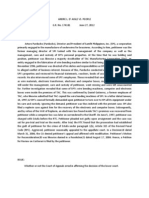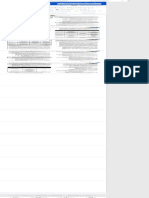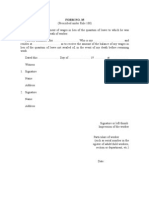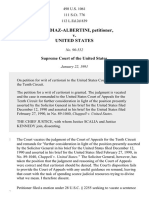Bibliography
Bibliography
Uploaded by
maryjoensCopyright:
Available Formats
Bibliography
Bibliography
Uploaded by
maryjoensOriginal Description:
Copyright
Available Formats
Share this document
Did you find this document useful?
Is this content inappropriate?
Copyright:
Available Formats
Bibliography
Bibliography
Uploaded by
maryjoensCopyright:
Available Formats
Bibliography
Primary Sources Biddle, Francis. "The Nrnberg Trial." In Perspectives on the Nuremberg Trial, 200-12. Oxford: Oxford University Press, 2008. Francis Biddle, the primary American judge of the IMT, wrote this short piece only months after the conclusion of the trials. His purpose was largely to clarify common misconceptions about the trial - primarily their "root in victor's justice." This article helped clarify some essential points of the trial and its justification for me. Dodd, Christopher J., and Lary Bloom. Letters from Nuremberg: My Father's Narrative of a Quest for Justice. New York: Crown Pub., 2007. Print. This is a collection of letters written by Thomas Dodd to his family members back home detailing the events of the International Military Tribunal and his involvement in it. These provide a unique first-hand look at what the prosecution team was doing in Nuremberg and helped provide a better understanding of the prosecutors' strategy and mentality throughout the trial. European Advisory Council. Charter of the International Military Tribunal - Annex to the Agreement for the Prosecution and Punishment of the Major War Criminals of the uropean Axis ("London Agreement"). August 8, 1945. The Charter of the IMT, commonly known as the "London Charter," authorized the formation of the International Military Tribunal and outlined the rules and procedures it was to follow. This is one of the central documents of the trial, and its contents were drawn upon in future trials and in the Rome Statute. It was incredibly important to this project, and it is featured in full on the website. General Assembly Resolution 60/1, Resolution adopted by the General Assembly, A/RES/60/1 (24 October 2005), available from undocs.org/A/RES/60/1 The resolution of the General Assembly at the UNs sixtieth session formally put in place the responsibility to protect standard, which assigns the responsibility to intervene in the case of serious human rights violations to the international community. This resolution is a part of the legacy of the Nuremberg Trials, which first set in place the standards of what a crime against humanity is and how they should be handed internationally. This original source document was greatly helpful to my research in that it illustrated how far the international community has come in taking on the responsibility to protect human rights.
Germany (Territory under Allied Occupation, 1945-1955). Enactments and Approved Papers of the Control Council and Coordinating Committee. 9 vols. Berlin, 1945-48. http://www.loc.gov/rr/frd/Military_Law/enactments-home.html. This 9-volume publication provides insight into how the Allied Control Authority jointly managed post-WWII occupied Germany by unanimous agreement between the four occupying powers during the time between the German surrender and the beginning of the Cold War. Goldensohn, Leon. The Nuremberg Interviews: An American Psychiatrist's Conversations with the Defendants and Witnesses. Edited by Robert Gellately. New York: Vintage Books, 2005. This book contains several personal interviews with the defendants of the Nuremberg Trials by the psychologist Leon Goldensohn. It provided surprising and useful insights into the mindset of the defendants as they stood trial. Greater German Reich. Reichstag. Reich Citizenship Laws. N.p.: n.p., n.d. US Holocaust Memorial Museum. Web. <http://www.ushmm.org/wlc/en/article.php?ModuleId=10007903>. The Nuremberg Laws were a set of radically Anti-Semitic laws put forth by the Nazi government in 1935. These laws set in motion a great deal of the following human rights violations in Germany, which was a large focus of the trial. Reading the laws as they originally were was essential to my research because it provided indispensable context for the German government's treatment of the Jewish population. Greater German Reich. Reichstag. The Laws for the Protection of German Blood and German Honour. N.p.: n.p., n.d. US Holocaust Memorial Museum. Web. <http://www.ushmm.org/wlc/en/article.php?ModuleId=10007903>. As with the Reich Citizenship Laws, the Laws for the Protection of German Blood and German Honour are considered the foundation of the mass racial discrimination against Jews in the third Reich. These laws limited the rights of Jews to marry, employ Germans, or identify as German people. Reading these laws was essential to understanding why the Third Reichs racial discrimination was considered a crime against humanity. Invasion of Poland in 1939 by the German Army. National Archives, 1943. Online. This is archived footage of the Nazi Invasion of Poland, originally released in 1943 by the US War Department. The firsthand look at the invasion is fascinating and helps show the extent to which Germans violated international law during WWII. A clip of the footage is featured on the website. Jackson, Robert H. "Justice Jackson's Opening Statement for the Prosecution." Speech, Trial of the Major War Criminals Before the International Military Tribunal, Palace of Justice, Nuremberg, November 21, 1945. Accessed September 2, 2013.
Robert Jackson's opening statement at the Nuremberg Trials is a famous and fascinating piece. In it, he not only explicitly states the aims of the IMT in terms of prosecution, but accounts for the obligation the IMT has to establish a precedent for the future of international law, and how they must be very aware of their legacy. This is one of the essential documents of the trial, and was pivotal in my research. Jackson, Robert H. "The Challenge of International Lawlessness." Perspectives on the Nuremberg Trial. Oxford: Oxford UP, 2008. 5-12. Print. This article, written by Justice Robert Jackson, details the challenges that face international law and justice. He outlines why he believes international cooperative efforts must be made to uphold justice in the future, and how he thinks an international court system modeled after Nuremberg could help achieve this. League of Nations. Treaty of Peace Between the Allied and Associated Powers and Germany ("Treaty of Versailles"). June 28, 1919. Versailles. This treaty, commonly known as the "Treaty of Versailles," brought an end to World War I. It was an essential document to my understanding of the post-WWI international community, and important parts of it are excerpted on the website. Nazi Concentration Camps. Directed by George Stevens. Washington: The Counsel, 1945. Online. This film about the Nazi concentration camp system was presented as evidence at the Nuremberg Trials. It provides a wealth of information about the how the system was run, its leadership, and the conditions endured by its prisoners. A clip of the film is found in the "Trial Proceedings" section of the website. Office of United States Chief of Counsel for Prosecution of Axis Criminality. Nazi Conspiracy and Aggression ("Red Series"). 8 vols. Wachington, DC: U.S. G.P.O., 1946. http://www.loc.gov/rr/frd/Military_Law/NT_Nazi-conspiracy.html. This eight-volume, 12-book publication makes available an indexed sampling of the evidence used to support the charges made against the major Nazi war criminals in their trial at Nuremberg. Used as a reference to gain insight into the details of the proceedings. The Nazi Plan. Directed by George Stevens. 1945. Online. This film was presented as evidence at the Nuremberg Trials, primarily to prove the count of conspiracy. It is composed of archival footage of Nazis preparing for war before WWII had broken out. A clip of it is found on the "Trial Proceedings" page of the website. Speer, Albert. Inside the Third Reich: Memoirs. New York: Macmillan, 1970.
This book is Albert Speer's personal memoirs, documenting his life and his work in the Third Reich. Not only did this provide an interesting and completely unique perspective of the Third Reich, but the epilogue about his experiences at the Nuremberg Trials provided new information and a completely different perspective of the trial.
Taylor, Telford. The Anatomy of the Nuremberg Trials: A Personal Memoir. New York: Skyhorse Pub., 2013. This book is an account of the Trial from the perspective of Telford Taylor, a member of the prosecution team and the chief counsel of the Subsequent Nuremberg Proceedings. Taylor's account provided a thorough understanding of the "behind-thescenes" action of the trial, as well as what members of the prosecution staff and organization teams hoped the legacy of the trial would be. Trial of the Major War Criminals before the International Military Tribunal, Nuremberg, 14 November 1945 - 1 October 1946 ("Blue Series"). 42 vols. Nuremberg, 1947-1949. http://www.loc.gov/rr/frd/Military_Law/NT_major-war-criminals.html. This 42-volume publication is the official record of the trial of the major civilian and military leaders of Nazi Germany who were accused of war crimes. Used as a reference to gain insight into the details of the proceedings. Trials of War Criminals before the Nuernberg Military Tribunals Under Control Council Law No. 10 ("Green Series"). 15 vols. Washington, DC: U. S. Govt. Print. Off., 1949-53. http://www.loc.gov/rr/frd/Military_Law/NTs_war-criminals.html. This 15-volume publication focuses on the 12 trials of almost 200 defendants, including diplomats, politicians and jurists. It is the official record of the individual indictments and judgments. Used as a reference to gain insight into the details of the proceedings. United Nations Office of Legal Affairs. "Rome Statute of the International Criminal Court." Web Site of the Rome Statute of the International Criminal Court. December 19, 2003. http://untreaty.un.org/cod/icc/index.html. The Rome Statute is the document outlining the basis of the International Criminal Court, its restrictions, and its purpose. This document was integral to my understanding of the ICC and how it operates. United Nations War Crimes Commission. Law Reports of Trials of War Criminals. 15 vols. London: H. M. Stationery Off., 1947. http://www.loc.gov/rr/frd/Military_Law/lawreports-trials-war-criminals.html. This 15-volume publication summarizes the course of proceedings by the Nuremberg and Tokyo International Military Tribunals, excluding the major war criminals. Used as a reference to gain insight into major points of law that were raised and settled during the trials.
United States Counsel for War Crimes, comp. Permissible Medical Experiments. April 17, 1947. This document, commonly known as the "Nuremberg Code," outlines the rules of subject treatment in human experimentation. The document, still in use today, was a direct response to the Doctor's Trial, one of the subsequent Nuremberg proceedings. It is featured in full on the website. USA. Dept. of State. Office of Public Affairs. Report of Robert H. Jackson, United States Representative to the International Conference on Military Trials, London, 1945. By Robert H. Jackson. Washington, D.C.: Dept. of State, Division of Publications, Office of Public Affairs, 1945. This document, detailing the development of the IMT, provides very detailed insight into the complexity of the negotiations between countries with disparate political and legal systems to achieve a common charter for the International Military Tribunal in Nuremberg. Yale Law School Lillian Goldman Law Library. Avalon Project Website - The International Military Tribunal for Germany. Accessed August 19, 2013. http://avalon.law.yale.edu/subject_menus/imt.asp. This extensive collection of relevant primary documents was invaluable to the project. It contains the trial proceedings transcripts, London Charter, Indictment, and other primary sources. Several of these are featured on the website.
Secondary Sources A Brief History of the Responsibility to Protect (R2P). Anne-Marie Slaughter. The Foreign Policy Institute. May 9, 2013. This video is a brief but very informative overview of the Responsibility to Protect standard. A portion of the video in which Anne-Marie Slaughter discusses the standard is featured on the "International Criminal Court" section of the website. The video as a whole was a very effective introduction to the idea of the R2P. Aarons, Mark. "Justice Betrayed: Post-1945 Responses to Genocide." In The Legacy of Nuremberg: Civilising Influence or Institutionalised Vengeance?, 69-97. Leiden: Martinus Nijhoff Publishers, 2008. This article examines the international community's response to acts of genocide after World War II, and the failure of the international community to intervene in such acts. This article was beneficial to my understanding of why the formation of the International Criminal Court and meaningful application of international law has been such a slow process.
Abyssinia Crisis, 1935 - The Failure of the League of Nations. FlashBack GCSE Modern History Revision, 2012. Online. This short video about some of the biggest failures of the League of Nations to mediate conflict was a crucial example for my understanding of the League. It explains clearly and concisely some of the main problems of the League, and a clip of the video is used in the website. Booth, Cherie. "Prospects and Issues for the International Criminal Court: Lessons from Yugoslavia and Rwanda." In From Nuremberg to the Hague: The Future of International Criminal Justice, 157-92. Cambridge: Cambridge University Press, 2003. This article explores the possibilities - positive and negative - for the International Criminal Court in the future and explains in depth why the ICC must face these possibilities directly. It also explains the role of former ad-hoc tribunals in how the ICC operates. It provided a much clearer understanding of the complex issues and arguments surrounding the ICC. Clapham, Andrew. "Issues of Complexity, Complicity and Complementarity: From the Nuremberg Trials to the Dawn of the New International Criminal Court." In From Nuremberg to the Hague: The Future of International Criminal Justice, 30-67. Cambridge: Cambridge University Press, 2003. This article analyzes the precedents set by the Nuremberg Trials for international law, especially in the expansion of accountability to individuals rather than just states. It provided a greater understanding of the wide-reaching implications the Nuremberg Trials had for the future of international justice. Crawford, James. "The Drafting of the Rome Statute." In From Nuremberg to the Hague: The Future of International Criminal Justice, 109-56. Cambridge: Cambridge University Press, 2003. This article explains the major concepts of the Rome Statute as well as explaining the complexities involved in creating the document in the context of the international legal environment at the time the statute was written (the late 1990s). This source provided a clear understanding of how the Rome Statute was written and the reasoning behind some of its provisions. Cryer, Robert, Hkan Friman, Darryl Robinson, and Elizabeth Wilmshurst. An Introduction to International Criminal Law and Procedure. Cambridge, UK: Cambridge University Press, 2007. This book is a very in-depth explanation of the intricacies of the International Criminal Court. It was beneficial to my understanding of the court and how the Rome Statute's provisions led to the way the court operates today. Cryer, Robert. "International Criminal Law vs State Sovereignty: Another Round?" European Journal of International Law 16, no. 5 (2005): 979-1000.
This article examines the relationship between international law and state sovereignty, and analyzes some of the problems with the ongoing discussion about the relationship between the two. It helped me gain a better understanding of some of the reasons why the ICC's development was so delayed, and why its influence is still very limited. Damaska, Mirjan R. "The International Criminal Court Between Aspiration and Achievement." Faculty Scholarship Series. Paper 1572 (2009). This article explores the lack of enforcement power facing international courts, and how they can seek to increase their power in enforcing international law. It provided useful information about the challenges the International Criminal Court faces in its enforcement. Damaska, Mirjan R. "What Is the Point of International Criminal Justice?" Chicago-Kent Law Review 83, no. 1 (2008): 329-65. This article explores some problems facing the International Criminal Court in regards to its goals, examining the troubles the overabundance of goals could cause in the future. It provided an additional perspective about the widely debated ICC. Distel, Barbara. The Dachau Concentration Camp, 1933 to 1945: Text and Photo Documents from the Exhibition, with CD; [Catalogue for the Exhibition "The Dachau Concentration Camp 1933 - 1945"] Translated by aul owman achau omit nternational e Dachau, 2005. This detailed exhibition guide outlines the Dachau Concentration Camp Memorial exhibit. Provides insight into the daily lives of inmates, the cruelty of camp guards, and medical experiments performed on inmates. Douglas, Lawrence. The Memory of Judgment: Making Law and History in the Trials of the Holocaust. New Haven: Yale University Press, 2001. This book deals with the legal response to the Holocaust, both in the Nuremberg Trials and in later national trials. It provided useful information about the Nuremberg Trials and their role in bringing Nazi war crimes to light and making the general public aware of them. Dpartement Fdral Des Affaires trangres (DFAE), and Comit International De La CroixRouge (CICR). 60 Years of the Geneva Conventions and the Decades Ahead. Proceedings, International Conference Centre, Geneva, Switzerland. Langenthal: Merkur Druck AG, 2010. This source documents a conference held by the International Committee of the Red Cross to commemorate the 60th anniversary of the Geneva Conventions. It focused mostly on the applications of the Geneva Conventions in the future in the face of new threats to security. This was a useful source in the final section of my project, which focuses on how the legacy of the Nuremberg Trials will likely impact the future through international law.
Eigen, Ingo. "Documentation Center Nazi Party Rally Grounds." Interview by author. August 8, 2013. Personal Interview at the Documentation Center Nazi Party Rally Grounds in Nuremberg, Germany. The Documentation Center Nazi Party Rallying Grounds is a museum in the north wing of the unfinished remains of the Congress Hall of the former Nazi party rallies. Mr. Eigen is a subject matter expert for Verein Geschichte Fr Alle e.V. (History for Everyone - Institute for Local History) in Nuremberg. His insights into the German political system before and during WWII were incredibly valuable in my understanding of how the defendants were involved in the Nazi hierarchy. Eigen, Ingo. "Memorium Nuremberg Trials." Interview by author. August 5, 2013. Personal interview at the exhibits at the Memorium Nuremberg Trials in Nuremberg, Germany. Mr. Eigen is a subject matter expert for Verein Geschichte Fr Alle e.V. (History for Everyone - Institute for Local History) in Nuremberg. The focus of this interview was on the German reaction to the trials and how the subsequent proceedings were affected by the Cold War. This interview brought a lot of information to light about how Germans perceived the trial that I would not have otherwise had access to. Elsea, Jennifer K. U.S. U.S. Policy Regarding the International Criminal Court: Updated August 29, 2006. Rept. RL31495. Washington, DC: Congressional Research Service, 2006. This report describes the primary objection of the United States to the treaty, namely the s possible assertion of jurisdiction over U S soldiers charged with war crimes resulting from legitimate uses of force t argues that giving the such power could impinge on the sovereignty of the United States. Evans, Richard J. The Coming of the Third Reich: How the Nazis Destroyed Democracy and Seized Power in Germany. London: Penguin, 2004. This book outlines the rise of Nazi ideology and the rise of the Nazi party in the German government. It provided essential context for the events leading up the trial and some of the events that were brought up as evidence. Evans, Richard J. The Third Reich at War: How the Nazis Led Germany from Conquest to Disaster. London: Penguin, 2009. This book outlines the Nazi conspiracy to engage in a war of conquest, the concentration camp system, and other Nazi war crimes. It is incredibly important information for understanding the Nuremberg Trials, as many of the actions for which the Nazi leadership were tried are explained in this book. Evans, Richard J. The Third Reich in Power: How the Nazis Won over the Hearts and Minds of a Nation. London: Penguin Books, 2006.
This book explores the Nazi regime, its takeover of the civilian population, and the path it took toward war and genocide. It provided crucial context for the Nuremberg Trials, as much the the evidence used for conspiracy charges came from this time period. Goldsmith, Jack, and Daryl Levinson. "Law for States: International Law, Constitutional Law, Public Law." Harvard Law Review 122, no. 7 (2009): 1791-868. This article explains in depth the barriers between international law and domestic law due to the problems of uncertainty in international laws, enforcement, and sovereignty. It provided useful information about why many are still skeptical of a legal body enforcing international law. Heigl, Peter. N rnberg arl,
This book is a detailed documentation of the proceedings of the Nuremberg Trials, highlighting the actual events within the courtroom. It was useful in my understanding of how the trial was carried out, and how the London Charter's provisions were applied throughout the trial. Huhle, Rainer. ag: Der Lange Weg Zum Internationalen Strafgerichtshof = From Nuremberg to The Hague : The Long Road to the International Criminal Court N rnberg artlm llner, This publication from the Nuremberg Human Rights Center outlines the direct path of international law from Nuremberg to the International Criminal Court (ICC), explaining how the legacy of Nuremberg still impacts international law. This source was used primarily in the portion of the site devoted to Nuremberg's legacy, as it explains several of the long-term effects of the Trials. "The International Criminal Court and the Responsibility to Protect." International Coalition for the Responsibility to Protect. May 2, 2009. This article, published by the International Coalition for the Responsibility to Protect, highlights some of the key ways the ICC and R2P complement each other and can be used effectively as a unit in the future of international policy. Not only did it provide interesting insight into the connection between the two institutions, it clarified some key concepts about the role the R2P plays in international policy today. Inside the International Criminal Court. The Open University, 2013. Online. This film is a detailed examination of the ICC, its purpose, and how it has achieved its goals thus far. It has several personal interviews with important ICC members and legal professionals. The insider perspective about the ICC was intriguing, and a clip of the documentary is included on the "International Criminal Court" page of the website. Joens, Dietlinde. "Germany during and after World War II." Interview by author. August 11, 2013.
Personal eyewitness account of the era during and immediately after World War II. She was 16 at the time of the Nuremberg trials and experienced first-hand air raids and the destruction of war, children's evacuation (Kinderlandverschickung), famine, and the reconstruction of Germany after the war. Speaking with her provided a completely different perspective of the war and the trials, and she could also comment on what the feelings of the public as a whole were during the post-war years. Karstedt, Suzanne. "The Nuremberg Tribunal and German Society:International Justice and Local Judgment in Post-Conflict Reconstruction." In The Legacy of Nuremberg: Civilising Influence or Institutionalised Vengeance?, 13-35. Leiden: Martinus Nijhoff Publishers, 2008. This article focuses on how the Nuremberg Trials were perceived by the German public as well as analyzing the German psyche as a whole throughout the postwar period. It provided valuable information about the public reaction to the trial and how the trial affected German postwar society. Kelly, Michael J., and Timothy L. H. McCormack. "Contributions of the Nuremberg Trial to the Subsequent Development of International Law." In The Legacy of Nuremberg: Civilising Influence or Institutionalised Vengeance?, 101-29. Leiden: Martinus Nijhoff Publishers, 2008. This article is about how the Nuremberg Trials have affected the development of international law. It is an in-depth analysis of Nuremberg's role not just in in criminal law, but in the law of occupation. It provided valuable information about Nuremberg's far-reaching influence on international law. Kirsch, Philippe. From Nuremberg to The Hague: The Nuremberg Heritage: A Series of Events Commemorating the Beginning of the Nuremberg Trials. November 19, 2005. Speech, Court Room 600, Palace of Justice, Nuremberg. This speech, given at an event commemorating the 60th anniversary of the Trials, outlines the progress of international law since the Nuremberg Trials. It provided a good, basic framework of the progression of law from which I could add on more information. Kogon, Eugen. The Theory and Practice of Hell: The German Concentration Camps and the System behind Them. Translated by Heinz Norden. New York: Farrar, Straus and Giroux, 2006. This book is an in-depth account of the concentration camp system that was set up in Nazi Germany. The incredibly efficient organization of these camps and the documentation of their activities were used as evidence against the defendants in the Nuremberg Trials. This provided important information about what, exactly, the defendants were being tried for. KZ Buchenwald / Post Weimar. Dir. Margit Eschenbach. Chronos-Film, 1999. DVD. In addition to a chronological overview of Buchenwald Concentration Camp, this documentary contains eyewitness interviews and historic film material of the liberation of
the camp. This provided important context for the trial of Nazi war crimes, as it highlighted some of the most severe atrocities committed by Nazi authority figures. The Legacy of War. PBS, 2006. Online Video. This video, released by PBS, provides a brief overview of the Nuremberg Trials, focusing on the lead-up to the trial. It uses a lot of archival footage, some of which is featured on the "London Charter & Trial Preparation" page (Robert Jackson's remarks on aggressive war). The primary footage from this piece was especially helpful for me to gain a better understanding of how the trials worked. Liedkie, Josiah. The Nuremberg Trial: Robert H. Jackson and American National Autonomy. Thesis, Department of History Senior Seminar, Western Oregon University, 2013. This thesis explores how Robert Jackson's role in the trial helped to reinforce the idea of national autonomy within international legal systems. It provided an interesting perspective about the precedents Nuremberg set for national sovereignty. Make Germany Pay. Chicago, IL: Films Incorporated, 1977. Online. This documentary film focuses on Germany after World War I and how the Treaty of Versailles affected the country's economy and politics. This political and economic environment is in large art what gave rise to the Nazi Party, so it provided important historical context. A clip of this film is found on the "Rise of the Nazi Machine" section of the website. Martin, Roy A. White Mane Books, 2000. . Shippensburg, PA:
This book is the firsthand account of the trial from the perspective of Dr. Roy Martin, the attending physician for the Nuremberg defendants. Having a firsthand witness' account of the trial benefited my understanding of the intricacies of the trial and its organization outside the courtroom. McDougall, Carrie. "The Crime of Aggression: Born of the Failure of Collective Security Still Shackled to Its Fate? Time to Catch Up or Part Ways." In The Legacy of Nuremberg: Civilising Influence or Institutionalised Vengeance?, 131-67. Leiden: Martinus Nijhoff Publishers, 2008. This article deals primarily with the debate over the inclusion of crimes of aggression in the jurisdiction of the International Criminal Court. However, the article was mostly useful to me in its clear explanation of what a 'crime of aggression' truly is, as it is a somewhat ambiguous term that is used very frequently in the Nuremberg Trials. Mendez, Juan E. "60 Years After the Nuremberg Judgment: Challenges Facing the Fight Against Impunity." Lecture, Prosecution and Prevention of Genocide, Nuremberg, Germany. Accessed March 3, 2014.
This speech, given by a Special Adviser to the Security General on the Prevention of Genocide, connects the Nuremberg Trials, ICTY, ICTR, and the Responsibility to Protect standard simply and clearly. It shows how international law has progressed since the IMT, and how the Responsibility to Protect standard is currently enforced and will be enforced in the future. This speech greatly aided my understanding of the R2P and its connection to the Nuremberg Trials. Menzel, Dagmar. "Nazi Party Rally Grounds in Nuremberg." Interview by author. August 7, 2013. Extensive tour of the former Nazi Party rally grounds and Zeppelin field in Nuremberg, Germany, and personal conversation about the historic background. Ms. Menzel is an expert in the German-Jewish dialog and has in-depth knowledge of the Nazi era. Merkel, Reinhard. "The Law of the Nuremberg Trial: Valid, Dubious, Outdated." InPerspectives on the Nuremberg Trial, 555-76. Oxford: Oxford University Press, 2008. This article explores the Nuremberg Trials' legacy, and how it should be drawn upon by international legal bodies moving forward. It provided an interesting perspective about how the legal community has reacted to and wrangled with the problems presented by the Nuremberg Trials. Meron, Theodor. "Reflections on the Prosecution of War Crimes by International Tribunals." American Journal of International Law 100, no. 3 (2006): 551-79. This article focuses on the legacy of the Nuremberg Trials. It provided good background information about the trials and how they have affected international justice. Mgret, Frdric. "International Prosecutors: Accountability and Ethics." 2008. MS 18, Katholieke Universiteit Leuven, Leuven. This document addresses the issue of ethical standards of prosecution in international trials. It provided useful information about the complex issues facing the International Criminal Court, especially of prosecution ethics. ettraux, Gu na l udicial Inheritance: The Value and Significance of the Nuremberg Trial to Contemporary War Crimes Tribunals." In Perspectives on the Nuremberg Trial, 599-616. Oxford: Oxford University Press, 2008. This article is an extensive assessment of the Nuremberg Trials' legacy in international justice. It addresses both positive and negative perspectives of the trial, and in that provided an interesting and comprehensive view of the trials as a whole, adding another layer to my research. Nazi War Crimes and Japanese Imperial Government Records Interagency Working Group. Final Report to the United States Congress, April 2007. College Park, MD, 2007.
This report outlines new developments in historians' understanding of World War II war crimes through the government records of Germany and Japan. It provides interesting information regarding the WWII era and the role government documentation has played in shaping the historical understanding of WWII. The Nuremberg Trials. PBS, 2006. DVD. This documentary covers the trial proceedings in detail, complete with extensive archival footage of the trial itself. It provided a greater understanding of the trials process, as well as useful information about the film pieces submitted as evidence in the trial. Nuremberg: Tyranny on Trial. A&E Networks, 2005. DVD. This documentary provides extensive information about the lead-up to the Trial as well as the trial itself, containing several clips of archival footage. It provided background information about the trial and its immediate context. On the Tokyo Trials. Linda Holmes. Robert H. Jackson Center, 2006. Online Video. This video is a clip of historian Linda Holmes' lecture on international trials at SUNY Fredonia in 2006. In it, she discusses the challenges facing the International Military Tribunal for the Far East and some of the potential reasons why they were not as successful as the International Military Tribunal in Nuremberg. Her comments were very enlightening and helped me understand the IMTFE more deeply. A portion of this video is featured on the "International Military Tribunal for the Far East" page of the website. Overy, Richard. "The Nuremberg Trials: International Law in the Making." In From Nuremberg to the Hague: The Future of International Criminal Justice, 1-29. Cambridge: Cambridge University Press, 2003. This article explains in depth the means by which the International Military Tribunal was formed, and the political interests that influenced the way the trial was run. It explores many interesting points regarding the political motivations for the trial, which was useful in establishing the immediate context for the trial. Public Information and Documentation Section. Understanding the International Criminal Court. The Hague: Registry, International Criminal Court. This document, developed by the International Criminal Court provides a detailed and thorough explanation of the criminal court's jurisdiction, structure, and operation. It provided the basis for my understanding of the ICC. Putzger, Friedrich Wilhelm, Alfred Hansel, and Walter Leisering. Historischer Weltatlas. 85th ed. Bielefeld: Velhagen & Klasing, 1963. Collection of historical maps that helps to understand the changing political landscape of Europe from antiquity to today. From the 13th century onward, there are several maps per century. From 1914 onward, maps are very detailed, showing the impact
of World Wars I and II, the Nazi era, and German occupation after WW II, as well as economic, political and military pacts in Europe and worldwide after 1945. Questions on German History: Ideas, Forces, Decisions from 1800 to the Present : Historical Exhibition in the Berlin Reichstag : Catalogue. 3rd ed. Bonn: German Bundestag, Publications Section, 1989. Exhibition catalog giving a comprehensive, detailed overview over German history from the Congress of Vienna to just before German reunification. Includes charts of the National Socialist power network, and pre- and post-war German constitutional structures. Ryngaert, Cedric. "The International Prosecutor: Arrest and Detention." 2009. MS 24, Katholieke Universiteit Leuven, Leuven. This document deals with the issue of choosing defendants for the ICC, and the ethical and legal boundaries in doing so. It provided both a greater understanding of the operation of the ICC and useful information about the current issues facing the ICC. Shnayerson, Robert. "Judgment at Nuremberg." Smithsonian, October 1996, 124-41. This article provides a concise account of the formation of the International Military Tribunal, the trial, and the implications it holds for the future. It was a good source of background information about the trial itself. Simmons, Beth A., and Allison Danner. "Credible Commitments and the International Criminal Court." International Organization 64, no. 02 (2010): 225-56. This article explores the reasons why states would want to partially sacrifice sovereignty by submitting to the jurisdiction of the International Criminal Court. It helped to both provide a better understanding of why some states have yet to join the ICC as well as why they might join in the future. Stein, Harry. Buchenwald Concentration Camp, 1937-1945: A Guide to the Permanent Historical Exhibition dited by Gedenkst tte uchenwald G ttingen allstein, This guide to the Buchenwald Memorial Site provides a wealth of information about the Buchenwald Concentration Camp's organization, activities, and conditions. It provided a more detailed account of one of the major components of what the defendants were being tried for. Swiss Federal Department of Foreign Affairs. ABC of Human Rights. Mnsingen: Fischer AG, 2008. This source from the Swiss Federal Department of Foreign Affairs outlines the progression of human rights from the Enlightenment to the present day. It contains a glossary of terms frequently used in international human rights dialogue complete, which also outlines the current contexts of these terms. I used this source to gain a better understanding of the current state of human rights internationally.
Swiss Federal Department of Foreign Affairs. ABC of International Law. Bern: Stmpfli Publikationen, 2009. This source from the Swiss Department of Foreign Affairs outlines International Law, clearly outlining the relationship between domestic and international laws as well as explaining the way international law impacts sovereignty. It was a very useful source for understanding how current international law impacts domestic affairs. Vinck, P., and P. N. Pham. "Outreach Evaluation: The International Criminal Court in the Central African Republic." International Journal of Transitional Justice 4, no. 3 (2010): 421-42. This article examines the role public outreach plays in the general population's knowledge of the International Criminal Court, specifically in the Central African Republic. The study suggests that despite the fact that the ICC has affected the Central African Republic, its outreach efforts have left the public in the dark. This was an interesting perspective on the public's role in and awareness of international justice. Voices from the Rwanda Tribunal. By Batya Friedman. University of Washington, 2010. Online. This short video summarizes a project at the University of Washington, intended to gather firsthand accounts of the Rwandan Genocide and the following trial. It provided interesting information regarding the International Military Tribunal for Rwanda, and a clip of it is featured on the "Ad-hoc Tribunals for Rwanda and the Former Yugoslavia" page of the website. Wald, Patricia M. "Dealing with Witnesses in War Crime Trials: Lessons from the Yugoslav Tribunal." Yale Human Rights and Development Law Journal, January 1, 2002, 217-39. This article focuses on how witness protection in the ad-hoc tribunal for Yugoslavia should be avoided in the ICC, arguing that the basis of a fair trial must be kept if the ICC is to be a legitimate legal institution. It provided an interesting perspective on the nature of a 'fair trial' and why the ICC must maintain procedures that are as transparent as possible. Washington, Ellis. The Nuremberg Trials: Last Tragedy of the Holocaust. Lanham: University Press of America, 2008. This book is a harsh criticism of the Nuremberg Trials on the basis of tribunal's jurisdiction, retroactive justice, and separation of morality from law. It provided an opposing perspective of the trial from most other scholars' interpretations. When the World Outlawed War. The Real News, 2011. Online. In this short video, author and activist David Swanson speaks about the KelloggBriand Pact and its goals in the regulation of warfare. It clearly explains the rather complicated pact, and a clip of it is featured on the website.
Whiting, Alex. "In International Criminal Prosecutions, Justice Delayed Can Be Justice Delivered." Harvard International Law Journal 50, no. 2 (2009): 323-64. This article explores the criticism of international tribunals being too slow to carry out justice, arguing that the delayed justice is preferable to high-stakes international trials being carried out too quickly. It offered a different and interesting perspective about the nature of international tribunals, which was useful in the sections of the site dealing with later international tribunals.
You might also like
- Closed Package No 1Document14 pagesClosed Package No 1RománNo ratings yet
- Guenter Lewy - Outlawing Genocide Denial - The Dilemmas of Official Historical Truth-The University of Utah Press (2014)Document210 pagesGuenter Lewy - Outlawing Genocide Denial - The Dilemmas of Official Historical Truth-The University of Utah Press (2014)Deusimar Lobao Veras Sobrinho100% (1)
- Alexander Laban Hinton - The Justice Facade - Trials of Transition in Cambodia-Oxford University Press (2018)Document305 pagesAlexander Laban Hinton - The Justice Facade - Trials of Transition in Cambodia-Oxford University Press (2018)hugaoxq qNo ratings yet
- Great Powers and Outlaw StatesDocument412 pagesGreat Powers and Outlaw StatesbobbyredmondNo ratings yet
- PoloO-02 2019-04-09 Decision On MeritsDocument43 pagesPoloO-02 2019-04-09 Decision On MeritsThe ProvinceNo ratings yet
- Annotated BibliographyDocument31 pagesAnnotated BibliographyginahanNo ratings yet
- Tomuschat, Christian - The Legacy of NurembergDocument15 pagesTomuschat, Christian - The Legacy of NurembergMax BenítezNo ratings yet
- Negotiating sovereignty and human rights: International society and the International Criminal CourtFrom EverandNegotiating sovereignty and human rights: International society and the International Criminal CourtNo ratings yet
- P.M.H. Bell - The Case of Katyn GravesDocument22 pagesP.M.H. Bell - The Case of Katyn GravesstefjansNo ratings yet
- Tratados MultilateralesDocument689 pagesTratados MultilateralesMelisa RamirezNo ratings yet
- The European Union and Member State Territories: A New Legal Framework Under The EU Treaties (Fiona Murray)Document306 pagesThe European Union and Member State Territories: A New Legal Framework Under The EU Treaties (Fiona Murray)punktlichNo ratings yet
- Vienna Convention On Road Traffic (1968)Document78 pagesVienna Convention On Road Traffic (1968)Sana IkramNo ratings yet
- Courtney Hercus - The Struggle Over Human Rights - The Non-Aligned Movement, Jimmy Carter, and Neoliberalism-Lexington Books (2019)Document224 pagesCourtney Hercus - The Struggle Over Human Rights - The Non-Aligned Movement, Jimmy Carter, and Neoliberalism-Lexington Books (2019)mohamed elazharNo ratings yet
- Goering's TrialDocument23 pagesGoering's TrialBMX2013No ratings yet
- International Law - 1950 PDFDocument398 pagesInternational Law - 1950 PDFhanna gabrielleNo ratings yet
- PSR 550Document160 pagesPSR 550AlvaroNo ratings yet
- International Human Rights Law in ContextDocument974 pagesInternational Human Rights Law in Contextopelob26No ratings yet
- Judges On TrialDocument493 pagesJudges On TrialADNo ratings yet
- House Hearing, 105TH Congress - The Consequences of Perjury and Related CrimesDocument194 pagesHouse Hearing, 105TH Congress - The Consequences of Perjury and Related CrimesScribd Government DocsNo ratings yet
- UNTS ChronoIndex41 PDFDocument269 pagesUNTS ChronoIndex41 PDFTakeshi FukudaNo ratings yet
- The Canadian War Crimes Liaison Detachment - Far East and The Prosecution of Japanese "Minor" War Crimes - Sweeney - MarkDocument332 pagesThe Canadian War Crimes Liaison Detachment - Far East and The Prosecution of Japanese "Minor" War Crimes - Sweeney - Markxib4esalesNo ratings yet
- Noam Chomsky - Ira Katznelson - Laura Nader - Richard C. Lewontin - Richard Ohmann - The Cold War & The University - Toward An Intellectual History of The Postwar Years-The New Press (1996) PDFDocument298 pagesNoam Chomsky - Ira Katznelson - Laura Nader - Richard C. Lewontin - Richard Ohmann - The Cold War & The University - Toward An Intellectual History of The Postwar Years-The New Press (1996) PDFGorka Sebastian Villar VasquezNo ratings yet
- Genocide As Crime LemkinDocument8 pagesGenocide As Crime LemkinRaphael T. SprengerNo ratings yet
- Nature of International LatestDocument54 pagesNature of International LatestAinnabila RosdiNo ratings yet
- Loto Dorado - Lanling Xiaoxiao ShengDocument148 pagesLoto Dorado - Lanling Xiaoxiao ShengAlbertoTorrezNo ratings yet
- Intl CRL Law-Syllabus-2023Document6 pagesIntl CRL Law-Syllabus-2023B Shivangi 1077No ratings yet
- Bradley Lightbody, Second World War PDFDocument301 pagesBradley Lightbody, Second World War PDFJuan100% (1)
- Making Endless WarDocument323 pagesMaking Endless Warritamitsoukouo100% (1)
- Expanding Histories of International Law: Martti KoskenniemiDocument9 pagesExpanding Histories of International Law: Martti KoskenniemisebahattinNo ratings yet
- The Wehrmacht War Crimes Bureau, 1939-1945 (Alfred M. de Zayas Howard Levie) (Z-Library)Document388 pagesThe Wehrmacht War Crimes Bureau, 1939-1945 (Alfred M. de Zayas Howard Levie) (Z-Library)depressionsoftcore0% (1)
- Protecting The Environment During Armed Conflict - An Inventory and Analysis of International Law 2009 PDFDocument88 pagesProtecting The Environment During Armed Conflict - An Inventory and Analysis of International Law 2009 PDFVinicius de CarvalhoNo ratings yet
- Organized CrimeDocument217 pagesOrganized Crimerorroloco0% (1)
- (R. C. H. Alexander) Insider Dealing and Money Lau (BookFi) PDFDocument289 pages(R. C. H. Alexander) Insider Dealing and Money Lau (BookFi) PDFTiko VegaNo ratings yet
- Grounds of Judgment Extraterritoriality and Imperial Power in Nineteenth-Century China and Japan PDFDocument273 pagesGrounds of Judgment Extraterritoriality and Imperial Power in Nineteenth-Century China and Japan PDF李东红No ratings yet
- The Genesis of The Order-Neisse Line - Gotthold Rhode and Wolfgang Wagner - 1959 - Brentano-Verlag - Anna's ArchiveDocument326 pagesThe Genesis of The Order-Neisse Line - Gotthold Rhode and Wolfgang Wagner - 1959 - Brentano-Verlag - Anna's ArchiveHugãoNo ratings yet
- CMN ICL Guidelines Command Responsibility en PDFDocument156 pagesCMN ICL Guidelines Command Responsibility en PDFbarrystarr1No ratings yet
- The OUN The UPA and The Nazi Genocide in PDFDocument14 pagesThe OUN The UPA and The Nazi Genocide in PDFantuhuentru100% (1)
- The Jews of Bohemia and Moravia Facing The Holocaust Comprehensive History of The Holocaust CompressDocument465 pagesThe Jews of Bohemia and Moravia Facing The Holocaust Comprehensive History of The Holocaust CompressSiscu Livesin DetroitNo ratings yet
- Politicalterrori 00 SobeDocument332 pagesPoliticalterrori 00 Sobepaulmazziotta50% (2)
- Command ResponsibilityDocument16 pagesCommand ResponsibilitySri VisvapriyaNo ratings yet
- International Criminal LawDocument3 pagesInternational Criminal LawAnirudh RanaNo ratings yet
- InvestigatinWomensRightsviolationArmedConflicts 2001Document114 pagesInvestigatinWomensRightsviolationArmedConflicts 2001Aileen ReyesNo ratings yet
- New International Economic Order (NIEO) : Giorgio SacerdotiDocument14 pagesNew International Economic Order (NIEO) : Giorgio SacerdotiSiddharth soniNo ratings yet
- AIcombatingtorturemanualDocument335 pagesAIcombatingtorturemanualMac ItaraldeNo ratings yet
- Acculturation Parent-Child RelationshipDocument885 pagesAcculturation Parent-Child RelationshipJosué Meléndez CoxNo ratings yet
- Vienna ConventionDocument11 pagesVienna ConventionWillard Enrique MacaraanNo ratings yet
- The Rise and Fall of Law and Economics - An Essay For Judge Guido Por UGO MATTEIDocument31 pagesThe Rise and Fall of Law and Economics - An Essay For Judge Guido Por UGO MATTEIHaroldo PereiraNo ratings yet
- European Community and Union Law and Domestic (Municipal) LawDocument9 pagesEuropean Community and Union Law and Domestic (Municipal) LawSiddharth soniNo ratings yet
- Blasphemy Laws Report MeasuringDocument152 pagesBlasphemy Laws Report MeasuringAnak Agung Ayu Nanda SaraswatiNo ratings yet
- Improving International Investment Agreements-Routledge (2013) PDFDocument441 pagesImproving International Investment Agreements-Routledge (2013) PDFEdmund KhoveyNo ratings yet
- International Humanitarian Law Flowchart 2Document1 pageInternational Humanitarian Law Flowchart 2Rainier Rhett ConchaNo ratings yet
- Proving Genocide - Forensic Anthropologists Role in Developing EvDocument158 pagesProving Genocide - Forensic Anthropologists Role in Developing EvKomakech WilfredNo ratings yet
- The Industrialization of Terrorist Propaganda - CTECDocument17 pagesThe Industrialization of Terrorist Propaganda - CTECmichaelciavarella216No ratings yet
- The International Criminal Court: History and Role: Laura BarnettDocument32 pagesThe International Criminal Court: History and Role: Laura BarnettlazylawatudentNo ratings yet
- International Consensus Essential Elements of DemocracyDocument16 pagesInternational Consensus Essential Elements of DemocracyawaisNo ratings yet
- Functional Responsibility of International Organisations The European Union and International Economic Law (Emilija Leinarte)Document292 pagesFunctional Responsibility of International Organisations The European Union and International Economic Law (Emilija Leinarte)andremiguelrosa5352No ratings yet
- Wolfrum-International LawDocument20 pagesWolfrum-International LawOana IlieNo ratings yet
- The Handbook of National Legislatures PDFDocument810 pagesThe Handbook of National Legislatures PDFGustavo SabbagNo ratings yet
- 26-04-2013 ICC - Decision On Defence Application Pursuant To Article 64 (4) and Related RequestsDocument57 pages26-04-2013 ICC - Decision On Defence Application Pursuant To Article 64 (4) and Related RequestsReportingKenya.netNo ratings yet
- The Oxford Handbook of International Law in Asia and The Pacific by Chesterman. Owada Saul Pages 1117 140Document25 pagesThe Oxford Handbook of International Law in Asia and The Pacific by Chesterman. Owada Saul Pages 1117 140johnjosephgabito.escoteNo ratings yet
- Accordance with international law of the unilateral declaration of independence in respect of KosovoFrom EverandAccordance with international law of the unilateral declaration of independence in respect of KosovoNo ratings yet
- 3 Implied TermsDocument6 pages3 Implied TermsJaskeeratNo ratings yet
- Andre L D' Aigle vs. PeopleDocument2 pagesAndre L D' Aigle vs. Peoplevrito_1100% (1)
- Law On Partnership Reviewer Reychelle Arimado - Academia - EduDocument1 pageLaw On Partnership Reviewer Reychelle Arimado - Academia - EduJewel Marie Brosas CoronadoNo ratings yet
- 1993 SCMR 2204Document5 pages1993 SCMR 2204Adv Sohail BhattiNo ratings yet
- Levy and Spiller (1996) Summary - After ClassDocument3 pagesLevy and Spiller (1996) Summary - After ClassCarmel Jorgensen100% (1)
- Compromise AgreementDocument5 pagesCompromise AgreementANGEL JOY RABAGONo ratings yet
- Sangguniang Barangay NG Don Mariano Vs MartinezDocument3 pagesSangguniang Barangay NG Don Mariano Vs MartinezRaymond RoqueNo ratings yet
- Form 35Document1 pageForm 35hdpanchal860% (1)
- Katarungang PambarangayDocument31 pagesKatarungang Pambarangayruss8diko100% (2)
- Crimlaw FAQs MATRIX-2019Document12 pagesCrimlaw FAQs MATRIX-2019RONILO YSMAELNo ratings yet
- RFBT Chapter2 OutlineDocument20 pagesRFBT Chapter2 OutlineCheriferDahangCoNo ratings yet
- Francisco vs. NLRC: G.R. No. 170087Document1 pageFrancisco vs. NLRC: G.R. No. 170087scartoneros_1No ratings yet
- Oscar Diaz-Albertini v. United States, 498 U.S. 1061 (1991)Document3 pagesOscar Diaz-Albertini v. United States, 498 U.S. 1061 (1991)Scribd Government DocsNo ratings yet
- Whaley V WatsonDocument2 pagesWhaley V WatsonEmily Hancox0% (1)
- Master Thesis On Human Trafficking in IndiaDocument4 pagesMaster Thesis On Human Trafficking in Indiasaralewisdenver100% (2)
- Transforming Philosophy and Religion - Love's Wisdom - Norman Wirzba and Bruce Ellis Benson, Eds (Indiana Series in The Philosophy of Religion) 2008Document273 pagesTransforming Philosophy and Religion - Love's Wisdom - Norman Wirzba and Bruce Ellis Benson, Eds (Indiana Series in The Philosophy of Religion) 2008Jason Wolfe100% (2)
- cD-69. People vs. NaranjaDocument1 pagecD-69. People vs. NaranjaBingoheartNo ratings yet
- BPI v. CBP, G.R. No. 197593, October 12, 2020Document9 pagesBPI v. CBP, G.R. No. 197593, October 12, 2020Reynald CruzNo ratings yet
- Theory and Practice in Public Administration: Module Iv - Organizational Structures of Philippine Public AdiministrationDocument17 pagesTheory and Practice in Public Administration: Module Iv - Organizational Structures of Philippine Public AdiministrationJennet GranadaNo ratings yet
- Warren v. District of Columbia 444 A 2d 1Document13 pagesWarren v. District of Columbia 444 A 2d 1Tracy James Justice JrNo ratings yet
- Case Facts Issue + RulingDocument4 pagesCase Facts Issue + RulingNN DDLNo ratings yet
- Pgd-Test DrillDocument11 pagesPgd-Test Drillkristel ludangcoNo ratings yet
- Perez Vs Dela TorreDocument2 pagesPerez Vs Dela TorreDash75% (4)
- Intellectual Property Rights Topics For DissertationDocument7 pagesIntellectual Property Rights Topics For DissertationDoMyCollegePaperNorman100% (1)
- A Legal Action Without Having To Pay For Court Fees or Costs Due To An Indigent's Lack of Financial ResourcesDocument9 pagesA Legal Action Without Having To Pay For Court Fees or Costs Due To An Indigent's Lack of Financial ResourcesCaroline LeeNo ratings yet
- Corp and White Collar Crimes LLM AssignmentDocument17 pagesCorp and White Collar Crimes LLM AssignmentVaibhav GadhveerNo ratings yet
- Hubtown Case-Brief Profile (1) - I: NtroductionDocument2 pagesHubtown Case-Brief Profile (1) - I: Ntroductionayushi2193No ratings yet
- Appellan'ts Brief CRIM (TO SC)Document7 pagesAppellan'ts Brief CRIM (TO SC)bobbyrickyNo ratings yet
- Stinnett v. BucheleDocument2 pagesStinnett v. BuchelecrlstinaaaNo ratings yet





